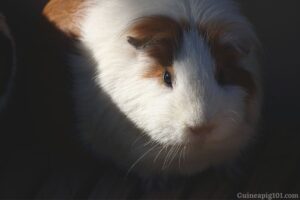Let’s first learn about some of the elements found in radicchio, so we may better balance the diet of our guinea pig.
Nutrition in radicchio?
| Nutrients | Amount |
|---|---|
| Vitamin C | 8 mg/ 100 g |
| Vitamin K | 255.2 µg/100 g |
| Vitamin A | 1 µg/ 100 g |
| Magnesium | 13 µg/ 100 g |
| Calcium | 19 mg/ 100 g |
| Phosphorous | 40 mg/ 100 g |
| Potassium | 302 mg/ 100 g |
| Fiber | 0.9 g/ 100 g |
| Sugar | 0.6 g/ 100 g |
| Protein | 1.43 g/ 100 g |
| Carbs | 4.48 g/ 100 g |
| Sodium | 22 mg/ 100 g |
| Fat | 0.25 g/ 100 g |
| Water | 93.14 g/ 100 g |
Here is a list of some essential nutrients present in radicchio:
- Vitamin K: Radicchio contains a good amount of Vitamin K, which plays a massive role in preventing blood clots and protein for bones.
- Consuming Vitamin K also minimizes the chance of fracture in older guinea pigs with weak bones. It is also very effective in counteracting overdose of blood. Like any other vitamin, it is not used as a dietary supplement.
- According to studies, Vitamin K deficiencies are rare in adults and are mostly found in newborn babies.
- Magnesium: Radicchio also contains a decent amount of magnesium which provides numerous benefits to the body as it helps to fight with depression.
- It also helps to regulate blood pressure and protect the body from type 2 diabetes
- Sodium: Radicchio also holds a good amount of sodium, which provides several benefits to the body.
- It reduces the chances of heart attack, helps to maintain blood pressure, helps prevent kidney damage, and protects against many other diseases.
- Potassium: Radicchio also holds a good amount of potassium, which is very important macrominerals needed by our body, helping to minimize blood and water retention.
- Potassium also protects from kidney stones and several other diseases.
- Lacking potassium can lead to many problems like weakness and constipation. But excessive intake of potassium can lead to hyperkalemia.
Is radicchio safe for guinea pigs?
Yes, radicchio is completely safe for our guinea pigs to consume. There are numerous advantages that our guinea pigs can reap from eating radicchio.
The following are some of the most typical advantages of feeding radicchio to our guinea pig:
- Hydrates the body: Radicchio has a high water content, which gives several benefits to our guinea pigs as it helps to stay hydrated and protect against several other diseases.
- According to studies, guinea pigs require at least 80-100mls of water per day. Radicchio can fulfill the water requirement of our guinea pig.
- Fiber Content: Radicchio also holds a small amount of dietary fiber, which provides many benefits to our guinea pig as it helps in digestion and also helps to prevent many stomach issues.
- Calcium-phosphorus ratio: One of the most important benefits of radicchio is that it has a low calcium-phosphorus ratio, which helps lower the calcium consumption when served with high ratio foods. The ideal ratio of guinea pig food is 2:1.
- Rich in antioxidants: Radicchio also contains a good amount of lutein and zeaxanthin, which are also known as antioxidants which protect cells against free radicals and also play a very important role in preventing heart diseases.
- Antioxidants are very much required by our guinea pig to stay healthy.
Is radicchio good for guinea pigs?
In fact, radicchio is beneficial to our guinea pig if eaten in moderation because it contains a reasonable amount of sodium, phosphorus, fat, and acidic content for its size. Excessive consumption of alcohol might result in serious health consequences.
Let’s have a look at some of the consequences of providing our guinea pig an excessive amount of radicchio.
- Lack of vitamin c: Radicchio lacks Vitamin C, which is the most essential nutrient for our guinea pigs. That is why we cannot serve radicchio daily to our guinea pig.
- Guinea pigs require at least 90mg of Vitamin C daily as they cannot produce Vitamin C on their own.
- Phosphorus content: Radicchio also contains a small amount of phosphorus which, if consumed in an excessive quantity, can affect the growth and survival of our guinea pig.
- If our guinea pig intakes a high phosphorus diet, it many develop deposits of calcium phosphate, which can affect their growth and survival.
- Sodium content: Radicchio contains a small amount of sodium which, if not taken in a moderate quantity, can cause severe damage to our guinea pigs. Guinea pigs have a susceptible digestive system that can not digest sodium well. Thus, moderate feeding is recommended.
- Urinary Complications: Radicchio also holds a small amount of calcium which, if consumed in excessive quantities, can result in too many urinary complications to our guinea pigs like urinary stones, pain, or infections in the urinary tract.
- With growing age, the need for calcium decreases in our guinea pigs. Calcium is required in a young age for the formation of bones.
How often can guinea pigs have radicchio?
Guinea pigs can have radicchio two to three times a week in a moderate quantity.
Because it is deficient in Vitamin C and also includes significant amounts of sodium, phosphorus, fat, and other nutrients, it should not be consumed in big quantities.
Overfeeding of radicchio can result in serious health consequences such as urinary infection, diarrhea, and other complications.
How much radicchio can guinea pigs eat?
Guinea pigs can consume 1-2 small leaves of radicchio at a time, depending on their size. Moderation is the key to living a healthy life, so don’t serve more than you need to.
Because radicchio is deficient in Vitamin C, it cannot be fed to our guinea pigs on a daily basis. To provide a well-balanced meal for our guinea pigs, we must combine it with other vegetables that are high in Vitamin C.
I frequently combine radicchio with other Vitamin C-rich vegetables such as bell peppers, chards, kale, arugula, spinach, and other greens to help my clients maintain a healthy diet.
Make a healthy vegetable mixture and serve it in a bowl to satisfy your hunger. If you have guinea pigs, you should also check out this excellent veggie bowl for them. This item appeals to me because it does not flip over and is the right size for our guinea pigs.
Can guinea pigs eat radicchio lettuce every day?
No, we are unable to serve radicchio lettuce on a daily basis due to the high sodium level and acidity of the lettuce. Radicchio lettuce should only be offered on special occasions.
Because radicchio does not contain enough nutritional content, it should only be served as a special treat and should not be included in the child’s daily meal. It is necessary for them to consume fresh hay and vegetables on a regular basis.
Can guinea pigs eat radicchio stalks?
It is not recommended that guinea pigs be provided with lettuce stems because this can pose a choking hazard to them. We must make every effort to stay as far away from it as possible.
It would be great if you kept in mind that guinea pigs require a regular diet of fresh hay and vegetables.
You can also provide them with other tree branches that are safe, such as apple, willow, birch, and so on.
Can guinea pigs eat radicchio leaves?
Yes, guinea pigs can consume radicchio leaves, but they should not do so more than twice a week.
Make careful to thoroughly wash the leaves before using them to ensure that any pesticides or chemicals are not adhered to them.
Can guinea pigs eat cooked radicchio lettuce?
No, cooked radicchio lettuce is not suitable for consumption for Guinea pigs.
In this case, serving cooked radicchio lettuce is a bad choice because it contains a high concentration of sodium and oil, which can cause serious health problems for our test subject.
When feeding guinea pigs regularly, it is important to keep in mind that they must be fed only freshly cut hay and vegetables.
How to prepare radicchio lettuce for your guinea pigs?
Here are some simple techniques to prepare radicchio lettuce for your guinea pigs that everyone can do.
- The first step is to choose a radicchio lettuce for your guinea pig to eat with its head. It must be a dark green color and not brown in any way.
- After that, choose one or two leaves and thoroughly wash them to check that there are no dirt particles on the surface.
- The final step is to remove the stalks from the plants because they can provide a choking hazard to the animals. After removing the stalks, you can slice the leaves into smaller pieces to ensure that your guinea pig does not have any difficulty eating its meal while on the run.
- In the final phase, you will feed your guinea pig the meal you prepared earlier. You should serve it alongside some vegetables to ensure that your guinea pigs’ nutritional requirements are met.
- Remember to take out any vegetables that haven’t been eaten from the cage. Bacterial blooms are frequently found in the rotting flesh of fruits and vegetables. It also invites flies and vermin to your guinea pigs, which is a bad thing.
Pro tip:
You may also prepare the vegetable for a few days or a few serving at a time and utilize good quality vegetable storage containers for keeping the same fresh and ready.
It works like a charm, especially if you have a busy schedule. I personally use these fantastic Rubbermaid Freshworks storage containers that I acquired from amazon, and they work like a charm for me.
Conclusion: Guinea pigs and Radicchio
- Radicchio is a high-nutrient vegetable that is high in vitamins, minerals, and dietary fiber. A small amount of this supplement gives several benefits to our test guinea pig when ingested in moderation.
- It is acceptable to offer radicchio twice a week in a moderate quantity because moderation is the key to living a healthy lifestyle.
- You can give your guinea pigs one or two small leaves of radicchio lettuce at a time, depending on their size.
- The use of excessive amounts of radicchio might result in major health consequences due to its high salt, phosphorus, and natural acid content.
- Cooked radicchio lettuce is not allowed to be offered to our guinea pig because it includes a high concentration of sodium and oil.
- Their usual food must include solely of fresh hay and vegetables; radicchio must not be included in their daily diet at all.




